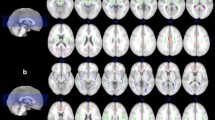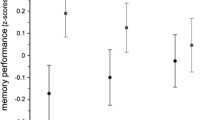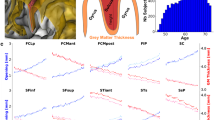Abstract
It has recently been reported that the evolutionarily ancestral alleles of two functional polymorphisms in the β2-adrenergic receptor gene (ADRB2) were related to higher cognitive ability in the 70 year old participants of the Lothian Birth Cohort 1936 (LBC1936). One emerging important factor in cognitive aging is the integrity of white matter tracts in the brain. Here, we used diffusion tensor MRI-based tractography to assess the integrity of eight white matter tracts in a subsample of the LBC1936. Higher integrity of the splenium of the corpus callosum predicted better cognitive ability in old age, even after controlling for IQ at age 11. Also, the ancestral allele of one ADRB2 SNP was associated with both splenium integrity and better cognitive aging. While the effects of the SNP and splenium integrity on cognitive aging were largely independent, there was some evidence for a partial mediation effect of ADRB2 status via splenium integrity.


Similar content being viewed by others
References
Abe O, Aoki S, Hayashi N, Yamada H, Kunimatsu A, Mori H et al (2002) Normal aging in the central nervous system: quantitative MR diffusion-tensor analysis. Neurobiol Aging 23:433–441
Allin M, Nosarti C, Narberhaus A, Walshe M, Frearson S, Kalpakidou A et al (2007) Growth of the corpus callosum in adolescents born preterm. Arch Pediatr Adolesc Med 161:1183–1189
Banich MT (1998) The missing link: the role of interhemispheric interaction in attentional processing. Brain Cogn 36:128–157
Baron RM, Kenny DA (1986) The moderator-mediator variable distinction in social psychological research: conceptual, strategic, and statistical considerations. J Pers Soc Psychol 51:1173–1182
Barrett JC, Fry B, Maller J, Daly MJ (2005) Haploview: analysis and visualization of LD and haplotype maps. Bioinformatics 21:263–265
Basser PJ, Pierpaoli C (1996) Microstructural and physiological features of tissues elucidated by quantitative-diffusion-tensor MRI. J Magn Reson B 111:209–219
Basser PJ, Mattiello J, Le Bihan D (1994) MR diffusion tensor spectroscopy and imaging. Biophys J 66:259–267
Bastin ME, Piatkowski JP, Storkey AJ, Brown LJ, Maclullich AM, Clayden JD (2008) Tract shape modelling provides evidence of topological change in corpus callosum genu during normal ageing. Neuroimage 43:20–28
Bastin ME, Clayden JD, Pattie A, Gerrish IF, Wardlaw JM, Deary IJ (2009) Diffusion tensor and magnetization transfer MRI measurements of periventricular white matter hyperintensities in old age. Neurobiol Aging 30:125–136
Bates TC, Luciano M, Lind PA, Wright MJ, Montgomery GW, Martin NG (2008) Recently-derived variants of brain-size genes ASPM, MCPH1, CDK5RAP and BRCA1 not associated with general cognition, reading or language. Intelligence 36:689–693
Beaulieu C (2002) The basis of anisotropic water diffusion in the nervous system: a technical review. NMR Biomed 15:435–455
Behrens TEJ, Berg HJ, Jbabdi S, Rushworth MFS, Woolrich MW (2007) Probabilistic diffusion tractography with multiple fibre orientations: what can we gain? Neuroimage 34:144–155
Bhagat YA, Beaulieu C (2004) Diffusion anisotropy in subcortical white matter and cortical gray matter: changes with aging and the role of CSF-suppression. J Magn Reson Imaging 20:216–227
Bochdanovits Z, Gosso FM, van den Berg L, Rizzu P, Polderman T, Pardo L et al (2009) A functional polymorphism under positive evolutionary selection in ADRB2 is associated with human intelligence with opposite effects in the young and the elderly. Behav Genet 39:15–23
Cabeza R (2002) Hemispheric asymmetry reduction in older adults: the HAROLD model. Psychol Aging 17:85–100
Cagliani R, Fumagalli M, Pozzoli U, Riva S, Comi GP, Torri F et al (2009) Diverse evolutionary histories for beta-adrenoreceptor genes in humans. Am J Hum Genet 85:64–75
Chepuri NB, Yen YF, Burdette JH, Li H, Moody DM, Maldjian JA (2002) Diffusion anisotropy in the corpus callosum. AJNR Am J Neuroradiol 23:803–808
Cheslack-Postava K, Fallin MD et al (2007) Beta2-Adrenergic receptor gene variants and risk for autism in the AGRE cohort. Mol Psychiatry 12:283–291
Clayden JD, Clark CA (2009) Model-based streamline rejection for probabilistic tractography. In: Proceedings of the ISMRM 17th scientific meeting and exhibition
Clayden JD, Storkey AJ, Bastin ME (2007) A probabilistic model-based approach to consistent white matter tract segmentation. IEEE Trans Med Imaging 26:1555–1561
Clayden JD, Storkey AJ, Muñoz Maniega S, Bastin ME (2009) Reproducibility of tract segmentation between sessions using an unsupervised modelling-based approach. Neuroimage 45:377–385
Cockcroft JR, Gazis AG, Cross DJ, Wheatley A, Dewar J, Hall IP, Noon JP (2000) ß2-adrenoceptor polymorphism determines vascular reactivity in humans. Hypertension 36:371–375
Scottish Council for Research in Education (1949) The trend of Scottish intelligence: a comparison of the 1947 and 1932 surveys of the intelligence of eleven-year-old pupils. University of London Press, London
De Keyser J, Steen C, Mostert JP, Koch MW (2008) Hypoperfusion of the cerebral white matter in multiple sclerosis: possible mechanisms and pathophysiological significance. J Cereb Blood Flow Metab 28:1645–1651
Deary IJ, Wright AF, Harris SE, Whalley LJ, Starr JM (2004) Searching for genetic influences on normal cognitive ageing. Trends Cogn Sci 8:178–184
Deary IJ, Bastin ME, Pattie A, Clayden JD, Whalley LJ, Starr JM et al (2006) White matter integrity and cognition in childhood and old age. Neurology 66:505–512
Deary IJ, Gow AJ, Taylor MD, Corley J, Brett C, Wilson V et al (2007) The Lothian Birth Cohort 1936: a study to examine influences on cognitive ageing from age 11 to age 70 and beyond. BMC Geriatr 7:28
Deary IJ, Corley J, Gow AJ, Harris SE, Houlihan LM, Marioni RE et al (2009a) Age-associated cognitive decline. Br Med Bull 92:135–152
Deary IJ, Johnson W, Houlihan LM (2009b) Genetic foundations of human intelligence. Hum Genet 126:215–232
Dennis N, Cabeza RC (2008) Neuroimaging of healthy cognitive aging. In: Craik FIM, Salthouse TA (eds) The handbook of aging and cognition, 3rd edn. Psychology Press, New York, pp 1–54
Diatchenko L, Anderson AD, Slade GD, Fillingim RB, Shabalina SA et al (2006) Three major haplotypes of the β2 adrenergic receptor define psychological profile, blood pressure, and the risk for development of a common musculoskeletal pain disorder. Am J Med Genet 141B:449–462
Evans PD, Gilbert SL, Mekel-Bobrov N, Vallender EJ, Anderson JR, Vaez-Azizi LM et al (2005) Microcephalin, a gene regulating brain size, continues to evolve adaptively in humans. Science 309:1717–1720. doi:10.1126/science.1113722
Flint J, Munafò MR (2007) The endophenotype concept in psychiatric genetics. Psychol Med 37:163–180
Folstein MF, Folstein SE, McHugh PR (1975) Mini-mental state. A practical method for grading the cognitive state of patients for the clinician. J Psychiatr Res 12:189–198
Gjesing AP, Andersen G, Burgdorf KS, Borch-Johnsen K, Jørgensen T, Hansen T, Pedersen O (2007) Studies of the associations between functional beta2-adrenergic receptor variants and obesity, hypertension and type 2 diabetes in 7, 808 white subjects. Diabetologia 50:563–568
Green AE, Munafò MR, DeYoung CG, Fossella JA, Fan J, Gray JR (2008) Using genetic data in cognitive neuroscience: from growing pains to genuine insights. Nat Rev Neurosci 9:710–720
Harris EE (2008) Searching the genome for our adaptations. Evol Anthropol 17:146–157
Harsan LA, Poulet P, Guignard B, Steibel J, Parizel N, de Sousa PL, Boehm N, Grucker D, Ghandour MS (2006) Brain dysmyelination and recovery assessment by noninvasive in vivo diffusion tensor magnetic resonance imaging. J Neurosci Res 83:392–402
Hasegawa I (2000) Neural mechanisms of memory retrieval: role of the prefrontal cortex. Rev Neurosci 11:113–125
Head D, Buckner RL, Shimony JS, Girton LE, Akbudak E, Conturo TE et al (2004) Differential vulnerability of anterior white matter in nondemented aging with minimal acceleration in dementia of the Alzheimer type: evidence from diffusion tensor imaging. Cereb Cortex 14:410–423
Hofer SM, Sliwinski MJ (2001) Understanding ageing: an evaluation of research designs for assessing the interdependence of ageing-related changes. Gerontology 47:341–352
Hua K, Zhang J, Wakana S, Jiang H, Li X, Reich D, Calabresi P, Pekar J, van Zijl P, Mori S (2008) Tract probability maps in stereotaxic spaces: analyses of white matter anatomy and tract-specific quantification. Neuroimage 39:336–347
Hutchinson AD, Mathias JL, Jacobson BL, Ruzic L, Bond AN, Banich MT (2009) Relationship between intelligence and the size and composition of the corpus callosum. Exp Brain Res 192:455–464
Johnson M (2006) Molecular mechanisms of β2-adrenergic receptor function, response, and regulation. J Allergy Clin Immunol 117:18–24
Jung RE, Haier RJ (2007) The parieto-frontal integration theory (P-FIT) of intelligence: converging neuroimaging evidence. Behav Brain Sci 30:135–154
Keller MC, Miller GF (2006a) Resolving the paradox of common, harmful, heritable mental disorders: which evolutionary genetic models work best? Behav Brain Sci 29:385–452
Keller MC, Miller GF (2006b) An evolutionary framework for mental disorders: integrating adaptationist and evolutionary genetic models. Behav Brain Sci 29:429–441
Kennedy KM, Raz N (2009) Aging white matter and cognition: differential effects of regional variations in diffusion properties on memory, executive functions, and speed. Neuropsychologia 47:916–927
Kidd KK (2009) ALFRED—the ALlele FREquency Database. Retrieved 7 Feb 2009, from http://alfred.med.yale.edu
Luders E, Narr KL, Bilder RM, Thompson PM, Szeszko PR, Hamilton L et al (2007) Positive correlations between corpus callosum thickness and intelligence. Neuroimage 37:1457–1464
Madden DJ, Whiting WL, Huettel SA, White LE, MacFall JR, Provenzale JM (2004) Diffusion tensor imaging of adult age differences in cerebral white matter: relation to response time. Neuroimage 21:1174–1181
Madden DJ, Spaniol J, Costello MC, Bucur B, White LE, Cabeza R, Davis SW, Dennis NA, Provenzale JM, Huettel SA (2008) Cerebral white matter integrity mediates adult age differences in cognitive performance. J Cogn Neurosci 21:289–302
Manolio TA, Collins FS, Cox NJ, Goldstein DB, Hindorff LA, Hunter DJ et al (2009) Finding the missing heritability of complex diseases. Nature 461:747–753
Mattay VS, Goldberg TE, Sambataro F, Weinberger DR (2008) Neurobiology of cognitive aging: insights from imaging genetics. Biol Psychol 79:9–22
McDaniel MA (2005) Big-brained people are smarter: a meta-analysis of the relationship between in vivo brain volume and intelligence. Intelligence 33:337–346
Mekel-Bobrov N, Gilbert SL, Evans PD, Vallender EJ, Anderson JR, Hudson RR et al (2005) Ongoing adaptive evolution of ASPM, a brain size determinant in homo sapiens. Science 309:1720–1722. doi:10.1126/science.1116815
Mekel-Bobrov N, Posthuma D, Gilbert SL, Lind P, Gosso MF, Luciano M et al (2007) The ongoing adaptive evolution of ASPM and microcephalin is not explained by increased intelligence. Hum Mol Genet 16:600–608. doi:10.1093/hmg/ddl487
Miller GF, Penke L (2007) The evolution of human intelligence and the coefficient of additive genetic variance in human brain size. Intelligence 35:97–114
Muñoz Maniega S, Bastin ME, McIntosh A, Lawrie S, Clayden JD (2008) Atlas-based reference tracts improve automatic white matter segmentation with neighbourhood tractography. In: Proceedings of the ISMRM 16th scientific meeting and exhibition, p 3318
O’Sullivan M, Jones DK, Summers PE, Morris RG, Williams SCR, Markus HS (2001) Evidence for cortical “disconnection” as a mechanism of age-related cognitive decline. Neurology 57:632–638
O’Sullivan M, Morris RG, Huckstep B, Jones DK, Williams SCR, Markus HS (2004) Diffusion tensor MRI correlates with executive dysfunction in patients with ischaemic leukoaraiosis. J Neurol Neurosurg Psychiatry 75:441–447
Ota M, Obata T, Akine Y, Ito H, Ikehira H, Asada T et al (2006) Age-related degeneration of corpus callosum measured with diffusion tensor imaging. Neuroimage 31:1445–1452
Park DC, Reuter-Lorenz P (2009) The adaptive brain: aging and neurocognitive scaffolding. Annu Rev Psychol 60:173–196
Penke L, Denissen JJA, Miller GF (2007a) The evolutionary genetics of personality. Eur J Pers 21:549–587
Penke L, Denissen JJA, Miller GF (2007b) Evolution, genes, and inter-disciplinary personality research. Eur J Pers 21:639–665
Pfefferbaum A, Sullivan EV (2003) Increased brain white matter diffusivity in normal adult aging: relationship to anisotropy and partial voluming. Magn Reson Med 49:953–961
Pfefferbaum A, Sullivan EV, Hedehus M, Lim KO, Adalsteinsson E, Moseley M (2000) Age-related decline in brain white matter anisotropy measured with spatially corrected echo-planar diffusion tensor imaging. Magn Reson Med 44:259–268
Pfefferbaum A, Adalsteinsson E, Sullivan EV (2005) Frontal circuitry degradation marks healthy adult aging: evidence from diffusion tensor imaging. Neuroimage 26:891–899
Pinelli M, Giacchetti M, Acquaviva F, Cocozza S, Donnarumma G, Lapice E, Riccardi G, Romano G, Vaccaro O, Monticelli A (2006) Beta2-adrenergic receptor and UCP3 variants modulate the relationship between age and type 2 diabetes mellitus. BMC Med Genet 7:85
Purcell S, Neale B et al (2007) PLINK: a tool set for whole-genome association and population-based linkage analyses. Am J Hum Genet 81:559–575
Roff DA, Fairbairn DJ (2007) The evolution of trade-offs: where are we? J Evol Biol 20:433–447
Salat DH, Tuch DS, Greve DN, van der Kouwe AJW, Hevelone ND, Zaleta AK et al (2005) Age-related alterations in white matter microstructure measured by diffusion tensor imaging. Neurobiol Aging 26:1215–1227
Song SK, Sun SW, Ramsbottom MJ, Chang C, Russell J, Cross AH (2002) Dysmyelination revealed through MRI as increased radial (but unchanged axial) diffusion of water. Neuroimage 17:1429–1436
Stanzione R, Di Angelantonio E, Evangelista A, Barbato D, Marchitti S, Zanda B, Pirisi A, Quarta G, Volpe M, Rubattu S (2007) Beta2-adrenergic receptor gene polymorphisms and risk of ischemic stroke. Am J Hypertens 20:657–662
Sullivan EV, Pfefferbaum A (2006) Diffusion tensor imaging and aging. Neurosci Biobehav Rev 30:749–761
Sullivan EV, Adalsteinsson E, Hedehus M, Ju C, Moseley M, Lim KO et al (2001) Equivalent disruption of regional white matter microstructure in ageing healthy men and women. Neuroreport 12:99–104
Sullivan EV, Adalsteinsson E, Pfefferbaum A (2006) Selective age-related degradation of anterior callosal fiber bundles quantified in vivowith fiber tracking. Cereb Cortex 16:1030–1039
Thomas PD, Kejariwal A (2004) Coding single-nucleotide polymorphisms associated with complex vs. Mendelian disease: evolutionary evidence for differences in molecular effects. Proc Natl Acad Sci USA 101:15398–15403
Tyszka JM, Readhead C, Bearer EL, Pautler RG, Jacobs RE (2006) Statistical diffusion tensor histology reveals regional dysmyelination effects in the shiverer mouse mutant. Neuroimage 29:1058–1065
Wechsler D (1998) WAIS-IIIUK administration and scoring manual. Psychological Corporation, London
Woods RP, Freimer NB, De Young JA, Fears SC, Sicotte NL, Service SK et al (2006) Normal variants of Microcephalin and ASPM do not account for brain size variability. Hum Mol Genet 15:2025–2029
Acknowledgments
LP, SMM and CM are funded by the UK Medical Research Council. LP, AJG, and the LBC1936 data collection were supported by the Disconnected Mind project (www.disconnectedmind.ed.ac.uk) funded by Help the Aged and Research into Ageing. JMW is part-funded by the Scottish Funding Council as part of the SINAPSE Collaboration. We thank the study secretary Paula Davies, Janie Corley and Ross Henderson for data collection and data entry; the nurses, radiographers and other staff at the Wellcome Trust Clinical Research Facility and the SFC Brain Imaging Research Centre (www.sbirc.ed.ac.uk) where the data were collected; and the staff at Lothian Health Board and at the SCRE Centre, University of Glasgow. The work was undertaken within The University of Edinburgh Centre for Cognitive Ageing and Cognitive Epidemiology, part of the cross council Lifelong Health and Wellbeing Initiative. Funding from the BBSRC, EPSRC, ESRC and MRC is gratefully acknowledged.
Author information
Authors and Affiliations
Corresponding author
Additional information
Edited by William Kremen.
Rights and permissions
About this article
Cite this article
Penke, L., Maniega, S.M., Houlihan, L.M. et al. White Matter Integrity in the Splenium of the Corpus Callosum is Related to Successful Cognitive Aging and Partly Mediates the Protective Effect of an Ancestral Polymorphism in ADRB2 . Behav Genet 40, 146–156 (2010). https://doi.org/10.1007/s10519-009-9318-4
Received:
Accepted:
Published:
Issue Date:
DOI: https://doi.org/10.1007/s10519-009-9318-4




